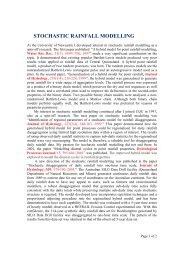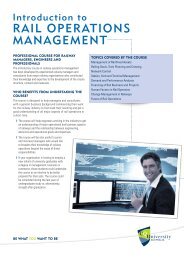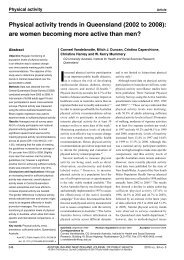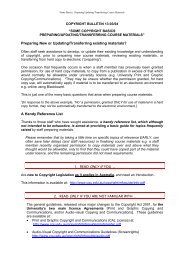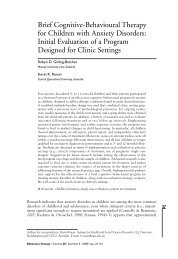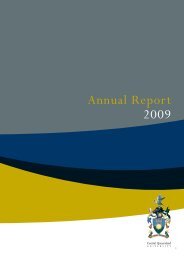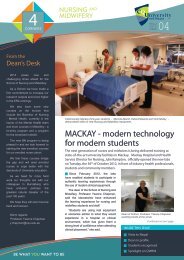CQUniversity Annual Report - Central Queensland University
CQUniversity Annual Report - Central Queensland University
CQUniversity Annual Report - Central Queensland University
- No tags were found...
You also want an ePaper? Increase the reach of your titles
YUMPU automatically turns print PDFs into web optimized ePapers that Google loves.
16<strong>Central</strong> <strong>Queensland</strong> <strong>University</strong>and Controlled EntitiesNotes to the Financial Statementsfor the year ended 31 December 2012(l)Investments and other financial assetsThe Group classifies its investments in the following categories: financial assets at fair value through profit or loss, loansand receivables, held-to-maturity investments, and available-for-sale financial assets. The classification depends on thepurpose for which the investments were acquired. Management determines the classification of its investments at initialrecognition and, in the case of assets classifed as held-to-maturity, re-evaluates this designation at each reporting date.(i) Financial assets at fair value through profit or lossFinancial assets at fair value through profit or loss include financial assets held for trading. A financial asset is classified inthis category if it is acquired principally for the purpose of selling in the short term. Assets in this category are classified ascurrent assets. There are no financial assets categorised as ‘financial assets at fair value through profit or loss’ as at 31December 2012.(ii) Loans and receivablesLoans and receivables are non-derivative financial assets with fixed or determinable payments that are not quoted in anactive market. They are included in current assets, except for those with maturities greater than 12 months after reportingdate which are classified as non-current assets. Loans and receivables are included in receivables in the statement offinancial position.(iii) Held-to-maturity investmentsHeld-to-maturity investments are non-derivative financial assets with fixed or determinable payments and fixed maturitiesthat the Group’s management has the positive intention and ability to hold to maturity.(iv) Available-for-sale financial assetsAvailable-for-sale financial assets, comprising principally marketable equity securities, are non-derivatives that are eitherdesignated in this category or not classified in any of the other categories. They are included in non-current assets apartfrom those which are available to be sold at short notice in an active market.Purchases and sales of financial assets are recognised on trade-date – the date on which the Group commits to purchaseor sell the asset. Investments are initially recognised at fair value plus transaction costs for all financial assets not carried atfair value through profit or loss. Financial assets carried at fair value through profit or loss, are initially recognised at fairvalue and transaction costs are expensed in other comprehensive income. Subsequent to initial recognition, they aremeasured at fair value and changes therein, other than impairment losses are recognised in other comprehensive incomeand presented in reserves in equity. Financial assets are de-recognised when the rights to receive cash flows from thefinancial assets have expired or have been transferred and the Group has transferred substantially all the risks andrewards of ownership.When securities classified as available-for-sale are sold, the accumulated fair value adjustments recognised in othercomprehensive income are included in the income statement as gains and losses from investment securities.Subsequent measurementAvailable-for-sale financial assets and financial assets at fair value through profit or loss are subsequently carried at fairvalue. Loans and receivables and held-to-maturity investments are carried at amortised cost using the effective interestmethod.ImpairmentThe Group assesses annually whether there is objective evidence that a financial asset or a group of financial assets areimpaired. If any such evidence exists an impairment loss is recognised in the income statement.(m)Investment propertiesInvestment properties exclude properties held to meet service delivery objectives of <strong>Central</strong> <strong>Queensland</strong> <strong>University</strong> and areheld to earn rental income and/or for capital appreciation.Investment properties are initially recognised at cost. Costs incurred subsequent to initial acquisition are capitalised when itis probable that future economic benefits in excess of the originally assessed performance of the asset will flow to <strong>Central</strong><strong>Queensland</strong> <strong>University</strong>. Where an investment property is acquired at no cost or for nominal consideration, its estimatedvalue shall be deemed to be its fair value, as at the date of acquisition.Subsequent to initial recognition at cost, investment property is carried at fair value, which is based on active market prices,adjusted, if necessary, for any difference in the nature, location or condition of the specific asset. If this information is notavailable, the Group uses alternative valuation methods such as recent prices in less active markets or discounted cashflow projections. These valuations are reviewed annually by a Registered Valuer. Changes in fair values are recorded inthe income statement.





